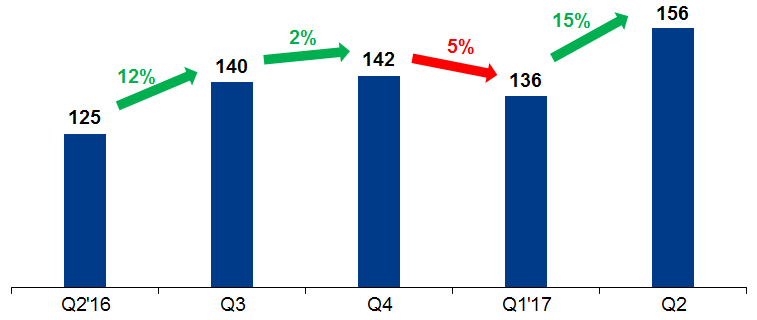Uber, Ola bookings bounce back post driver strikes
After three months of decline in cab bookings due to driver strikes, Uber, Ola saw a rise in booking during Q2 2017.

Key highlights:
- Indian online cabs market saw a growth of 15% in terms of ride count
- There was a 5% decline in the overall cab bookings for the industry in Q1 2017
- online cab market regained momentum post the driver strikes
Taxi-hailing apps Uber and Ola seem to have made a comeback in the second quarter in 2017 after bookings declined for the first time in Q1 2017. The Indian online cabs market saw a growth of 15% in terms of ride count.
The ride count during Q2 2017, which was in April, May and June, increased to 156 million from 136 million in the previous quarter (Q1 2017), according to a RedSeer Consulting report.

Source: RedSeer Consulting
This was as the online cab aggregators saw their services return to normal after the strikes that hit them in the first quarter of the year.
“The Online Cab Aggregator Industry returned to its growth track. Post the slowdown caused by strikes in major cities in the previous quarters, online cab market regained momentum and registered 15% growth in Q2 2017,” said the report.
There was a 5% decline in the overall cab bookings for the industry in Q1 2017. This is a first decline in app-based cab bookings in India.
The Indian online cabs market has been seeing a growth in terms of ride counts all throughout last year.
Online cab bookings increased by 80% from Q1 2016 to Q2 2016. It further increased by 12% in Q3 2016 and by 2% in Q4 2016.
However, the driver strikes in cities such as Delhi-NCR, Bengaluru and Mumbai had severely crippled the services of these online cab aggregators such as Uber and Ola. This had resulted in lower bookings and the monthly active users.
The reason for the driver strikes was due to the reduction in high incentives which these taxi-hailing app companies had once given them, in order to drive their profitability.
An earlier RedSeer Consulting report noted that driver income declined by 45% quarter on quarter (QoQ) due to a sharp reduction in ride incentives, by the online cab companies to push profitability.
It further said that first three months of this calendar year were marked by a clear tussle between growth and profitability. “Growing focus on profitability pushed players to cut down on driver incentives - a move which led to driver strikes across India, with the associated supply crunch contributing to a fall in rides for the industry,” it said.
As a result there was a drop in supply of cabs as many drivers chose to leave the online platforms and shift into other offline driving jobs or changed professions entirely.
On the other hand, car-pooling has seen a rapid growth in adoption in India during the last few quarters.
In Q2 2017 car-pooling it witnessed a 22% growth in comparison with the previous quarter. In Q1 2017 it had seen a steady growth of 9%.
This rise in demand for car-pooling services is helping these companies as there has been problems with the supply of cabs due to drivers going on strikes due to reduced incentives and their services being affected.
Car-pooling has helped to improve ride efficiency for drivers with more rides per trip and also helps to reduce the need for more drivers on the platform.
Besides this, the popularity of car-pooling due to the lower fares and greater convenience.
ALSO READ:
Get Latest Business News, Stock Market Updates and Videos; Check your tax outgo through Income Tax Calculator and save money through our Personal Finance coverage. Check Business Breaking News Live on Zee Business Twitter and Facebook. Subscribe on YouTube.
RECOMMENDED STORIES

Power of Compounding: How soon will monthly SIP of Rs 6,000, Rs 8,000, and Rs 10,000 reach Rs 5 crore corpus target?

SBI Guaranteed Return Scheme: Know how much maturity amount you will get on Rs 2 lakh, 2.5 lakh, 3 lakh, 3.5 lakh and Rs 4 lakh investments under Amrit Vrishti FD scheme

SBI Senior Citizen FD Rate: Here's what State Bank of India giving on 1-year, 3-year, 5-year fixed deposits currently

SBI Senior Citizen Latest FD Rates: What senior citizens can get on Rs 7 lakh, Rs 14 lakh, and Rs 21 lakh investments in Amrit Vrishti, 1-, 3-, and 5-year fixed deposits
05:17 PM IST









 Bookings on Ola, Uber decline for the first time in India; is the dream-run over?
Bookings on Ola, Uber decline for the first time in India; is the dream-run over?  Car-pooling service see growth in demand as Uber, Ola push for shared mobility
Car-pooling service see growth in demand as Uber, Ola push for shared mobility Govt mulling taking on Ola, Uber with its own app-based cab service
Govt mulling taking on Ola, Uber with its own app-based cab service  Court to pass order on plea against Ola, Uber on July 31
Court to pass order on plea against Ola, Uber on July 31 Maharashtra lifts ban on taxi, rickshaw licences but will commuters choose them over Uber, Ola?
Maharashtra lifts ban on taxi, rickshaw licences but will commuters choose them over Uber, Ola?